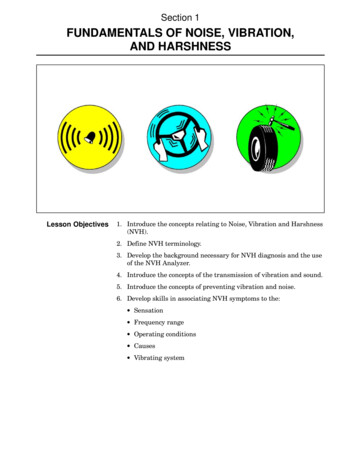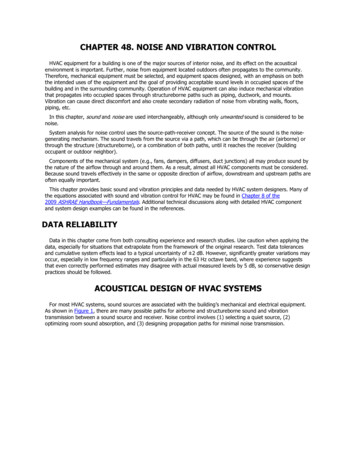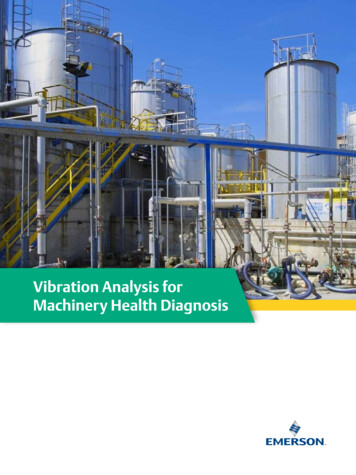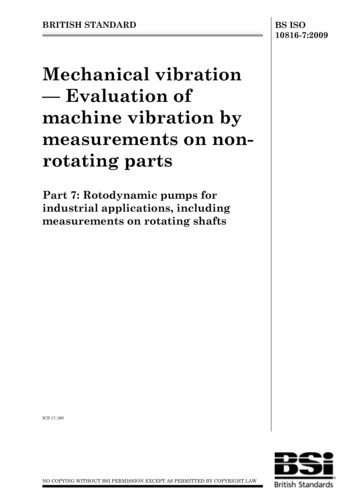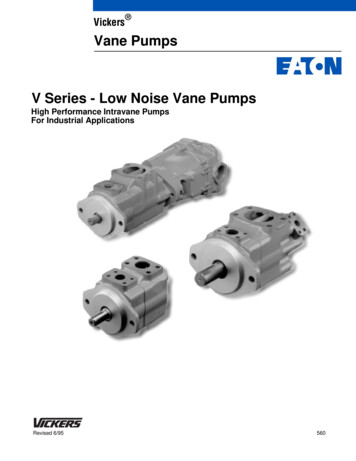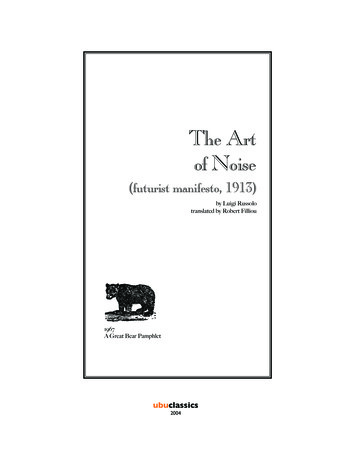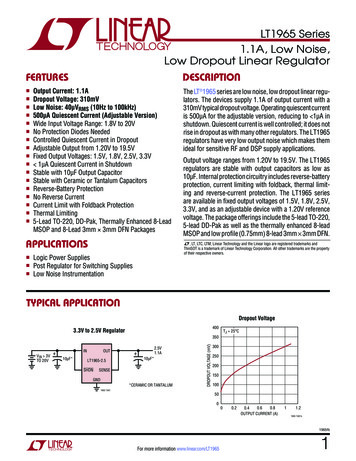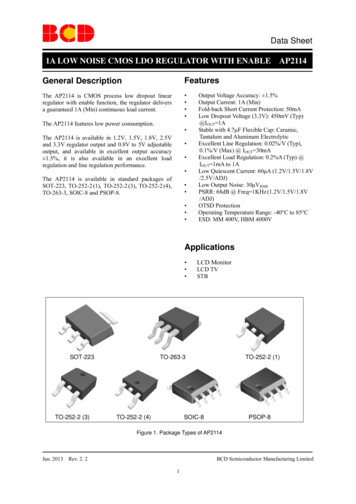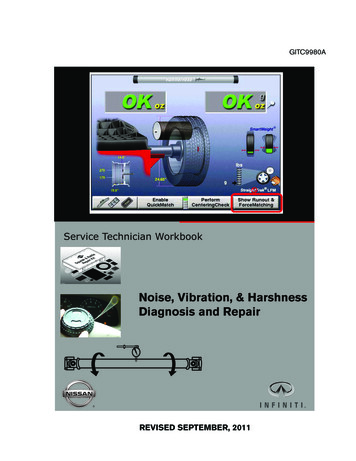
Transcription
GITC9980AService Technician WorkbookNoise, Vibration, & HarshnessDiagnosis and RepairREVISED SEPTEMBER, 2011
This book is designed for instructional useonly for authorized Nissan North America, Inc.and Nissan dealer personnel. For additionalinformation contact:Nissan North America, Inc.Technical TrainingP.O. Box 685001Franklin, TN 37068 2011 Nissan North America, Inc.All rights reserved. No part of this publicationmay be reproduced in any form without theprior written permission of the publisher.Nissan North America, Inc.Training DepartmentTechnical TrainingRevised Printing: September, 2011This manual uses postconsumer recycledfibersTraining DepartmentTechnical TrainingNissan North America, Inc. reserves the right to alter specifications or methods at any time.ii
NOISE, VIBRATION AND HARSHNESSTABLE OF CONTENTSSection 1: TextNoise, Vibration and Harshness . 1Squeak and Rattle Resources. 2NVH Troubleshooting Charts .2Squeak and Rattle Work Flow .3Squeak and Rattle Diagnostic Worksheet .4ASIST.6Virtual Academy . 7SIR Videos. 7Vibration Fundamentals . 8Vibration Elements. 8Cycle, Amplitude and Frequency . 9Frequency Chart. 11Resonance. 12Masking . 12Vibration Dampers . 12Origins of Vibrations. 14Vibration Order . 14Vibration Caused by Combustion . 15Misfire Order of Vibration. 16Vibration Frequency. 17Calculating Engine Order of Vibration . 17Driveline Order of Vibration . 17Wheel and Tire Vibration Frequency . 18Summary of typical Vibration Frequencies. 18iii
NVH Diagnostic Tools. 19Sirometer . 19Electronic Vibration Analyzer. 19EVA Components and Operation Description . 20Steelman Engine Ear. 26Steelman Chassis Ear. 27Digital Inclinometer . 29ASIST. 30Isolating Engine & Driveline Noises and Vibrations. 31Engine Related Noises . 31Engine Vibrations . 31Driveshaft Noises and Vibration . 32Rebro Joint Inspection . 34CV Driveshaft Inspection. 34Propshaft Imbalance. 35Propshaft Runout . 36Propshaft Balancing . 36Propshaft Angles. 39Inspecting the Center Bearing. 411 and 2 Piece Driveshaft (propshaft) Working Angles . 422nd Order Driveshaft Vibration. 43Lateral Driveshaft Alignment. 43Isolating Tire and Road Noises . 45Tire Related Noises . 46Radial Force Variation . 47Hunter GSP9700 . 48RFV Measurement . 49Matchmaker. 50iv
Brake Noise . 51Repairing Brake Noise. 52Corrective Action Chart. 54Wind Noise and Turbulence. 56Air Leaks . 56Sun Roof . 57Wind Noise Inspection . 57Road Testing . 58Pressurization Check and Inspection. 59Chalk Inspection. 60Powder Inspection . 60Dollar Bill ‘Fit’ Inspection. 60Soapy Water Inspection. 62Weatherstrip Repair Procedures . 63Heat Gun . 63Use of Adhesives . 63Body Lip Damage . 63Shimming Weatherstrip. 63Window, Door and Sunroof Adjustments . 64Squeaks and Rattle. 65Warranty Policy. 65Squeak and Rattle Diagnostic Worksheet . 67Test Drive Tips . 71Squeak and Rattle Resources . 72Virtual Academy . 72Special Tools . 73Squeak and Rattle Escalation Policy . 74v
Squeak and Rattle Kit Parts . 74Squeak and Rattle Characteristic Noises . 75Squeak and Rattle Verification and Repair . 77Instrument Panel . 78Center Console. 79Doors. 80Trunk . 81Sunroof and Headliner . 82Seats and Under Floor . 83Underhood . 84General Component Removal Procedures. 85Glossary . 86vi
Section 2: ModulesModule 1:Noise, Vibration and Harshness TerminologyModule 2:Using ASIST to Locate NVH Troubleshooting InformationModule 3:Verify and Isolate NVH Concern #1Module 4:Verify and Isolate NVH Concern #2Module 5:Verify and Isolate NVH Concern #3Module 6:Verify and Isolate NVH Concern #4Module 7:Driveshaft InspectionsModule 8:Isolating Chassis and Driveline NoisesModule 9:Testing for Air Leaks or Wind NoiseModule 10:Squeak and Rattle Diagnosis and RepairModule 11:Radial Force Variationvii
NOISE, VIBRATION AND HARSHNESSOBJECTIVES Given a classroom discussion and Power Point presentation, you will identify the fundamentals of Noise, Vibration and Harshness including the:-Definition, nature and causes of Vibration-Definition of Cycle, Amplitude and Frequency-Definition of Resonance-Explanation of 1st, 2nd or 3rd Order Vibrations-Explanation of how to calculate vibration Frequency-Identification of tools used to measure vibration Given an ASIST workstation, you will locate resource information available in TSBs and theESM which identify cause and correction procedures for NVH customer concerns. Given Vehicle #1 with a NVH problem, you will test drive the vehicle and verify the nature ofthe noise, vibration or harshness. You will use a Sirometer to measure the vibration frequency, calculate the ‘Order’ of the vibration and identify the cause of the problem. Given Vehicle #2 with a NVH problem, you will test drive the vehicle and verify a vibration feltin seat and steering wheel. You will use an Electronic Vibration Analyzer to measure both theFrequency and G forces of the vibration, and identify the cause of the problem. Given Vehicle #3 with a NVH problem, you will test drive the vehicle and verify a vibration atcruising speed. You will use a Sirometer or EVA to isolate the frequency of the vibrationproblem, then calculate and identify the component group causing the problem. Given Vehicle #4 with a NVH problem, you will test drive the vehicle and verify either ashimmy or shake in the steering wheel. You will measure driveline components and identifyany out of specification conditions that are causing the problem. Given a vehicle with a 1 or 2 piece driveshaft, you will measure the Driveshaft WorkingAngles. You will identify any problems and recommend corrections for any working anglesthat exceed recommended specifications. Given a vehicle with a NVH complaint, you will use a Steelman Chassis Ear to identify thecause of chassis or driveline noises. Given a vehicle with a concern of wind noise, you will use a Steelman Engine Ear to identifythe location of the air leak, and the components or repairs necessary to repair the problem. Given a vehicle with a NVH concern, you will check ASIST and the ESM for informationregarding the symptom. You will then verify the problem and indicate the required repairs. Given a wheel and tire assembly with Road Force Variation exceeding the recommended limits, you will use the Hunter GSP9700 to identify the tires RFV ‘high spot’. You will then forcematch the wheel and tire assembly to minimize RFV.viii
Course ProceduresClass begins promptly at 9:00 a.m. Please be in your seat and ready to begin at 9:00 a.m.Please silence your cell phones.Class ends when all the modules on the sign-off page of your guidebook are initialed by theinstructor. Nissan designs training so that most technicians should be able to complete all activities in the time allotted for the course. If you are unable to complete the requirements of thecourse in the time provided, your instructor will discuss options with you to receive coursecredit. You are responsible for learning the techniques and procedures featured in this course. Itis important you take as much time as you need to learn the skills presented in the course material. If you cannot complete the requirements of the course in the time provided, your instructorwill work with you and your dealership and help you complete the course.Text:The text contains information relating to the procedures, features and technology contained inthe material of this course. The instructor may assign reading from the text as homework, andsome of the text may help you answer questions included in the activities of this course. Readthe text section for detailed information regarding the technology featured in this training. It isrecommended that you save the text and use it in the future as a resource.Course Map:The course map indicates the order in which the modules should be completed. In the case ofsome training courses, certain modules must be completed before you begin other modules.Modules:1.Begin the module by reading the Objective, Relevance, Resources, and Skill Check on thefirst page. This information will present the basis for the skills included in the module.2.Read each step carefully to determine the appropriate actions or procedures the modulesare designed to impart.3.Pay attention to the Notes, Cautions, and Service Tips included in the module. In manyinstances, they will help you derive the answer to questions included in the module and willhelp you develop the skill sets intended by the design.4.You will probably be working with one or more technicians during this course. Follow thesebasic guidelines to work effectively as a team:-Take responsibility to understand and perform each step yourself.-When using diagnostic tools (CONSULT-III, multi-meters, etc.), be sure to check the onscreen results yourself and hand the tool to the other members of your group so they canconfirm the results as well.-If you are expected to test or remove and inspect a component, perform these procedures yourself and give the same opportunity to other members of your team.ix
-Be patient. Everyone works at different speeds. You are responsible to be able to performeach module objective - and you are responsible to ensure that others working with youcan
Nissan designs training so that most technicians should be able to complete all activ- ities in the time allotted for the cour
